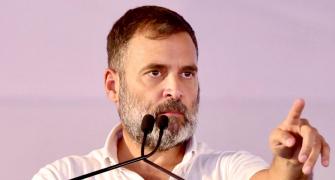The world's governments are shocked and dismayed by their inability to stop the increasingly grave financial crisis. Nothing they have attempted has gotten lending flowing normally. Profitable companies are cut off from borrowing. Confidence is shot.
Through Oct. 7 the U.S. stock market had its worst five-day performance since 1932 on fears of a severe economic downturn. Says Stephen Jen, currency economist at Morgan Stanley in London: "The choices for the real economy are between a recession and a depression."
Can anything be done to halt this panic? As a matter of fact, yes. It won't be quick or easy. But the prerequisite for a new approach is unlearning doctrines that were developed in the aftermath of the Great Depression, the last time financial conditions were worse than this. The world has changed in the intervening seven decades, and what worked to quell the financial crisis then may not work now - as anyone trying to borrow money can see.
So far, crisis managers in the US and abroad have relied mostly on using "helicopter money" - that is, dropping dollars across the financial landscape in hopes of reviving lending and spending. Generations of mainstream economists around the world learned this approach at the feet of the late Nobel laureate economist Milton Friedman, who coined the helicopter metaphor.
Federal Reserve Chairman Ben Bernanke, while parting from Friedman in some particulars, shares his general approach - and in fact earned the moniker "Helicopter Ben" after citing Friedman's coinage in a 2002 speech.
Following this logic, the Federal Reserve is aggressively lending money to all comers. The synchronized international rate cuts on Oct. 8 - which lowered the US federal funds rate to just 1.5% - is another example of helicopter money.
Central banks figure that by flooding the banking system with reserves, they can get banks to relend the money to the rest of the economy. But while lowering interest rates and providing liquidity is essential, it's no longer enough, says Paul J J Welfens, president of the European Institute for International Economic Relations in Wuppertal, Germany. Says Welfens: "It's very dangerous if you don't have a strategy. The situation is worsening because no one is doing a (basic) program to restore confidence."
An alternate approach that's gaining favor in many quarters is to place money strategically where it can do the most good, even if that means picking winners and losers and allowing some channels of credit to dry up for the time being. One tactic: direct government investments in selected banks on a large scale.
The theory behind this approach is that the banks are so wounded that simply lending them more money won't solve anything. To restore their positive net worth so they can lend freely, banks need fresh equity, and government is the only party that's capable of providing it in these extreme conditions. Sweden used this strategy to end a banking crisis in the early 1990s.
And on Oct. 8, Britain took a giant step in the same direction, announcing an offer to buy up to $88 billion worth of preferred shares in Britain's biggest banks. The government also said it would guarantee up to $437 billion of the banks' debt. "This is beginning a process of (undoing) a big problem where banks won't lend to each other for long periods," Chancellor Alistair Darling told Sky News.
On Oct. 8, US Treasury Secretary Henry Paulson broadly hinted that Washington is likely to use a targeted approach with at least some of the $700 billion authorized by Congress to deal with toxic mortgage-backed securities and other assets - including buying equity shares in some financial institutions.
A targeted approach doesn't waste money on weak banks that deserve to disappear. "You are going to see significant consolidation in banking across Europe. As the tide goes out, the weak models and weak managements are revealed," says Robert E. Diamond Jr., president of Barclays, the British banking company.
More policymakers and economists are coming around to approaches such as Britain's because of the manifest failure of loans, guarantees, and asset purchases to get the job done. In fact, an unhealthy dynamic has developed. The Fed and other central banks have steadily expanded the portions of the economy to which they are lending freely - in effect, declaring them to be protected within the walls of the fortress. But it's having unintended consequences.
Central bankers' desperate extension of credit to new kinds of borrowers simply worsens the condition of solvent institutions left outside the walls, because investors and lenders pull money out of them. That explains the wild swings in stock prices and credit spreads.
For example, the branches of British-owned banks in Ireland lost money to locally owned rivals after Dublin offered blanket protection on all deposits of Irish-owned banks there. And in the US, corporations that borrow in the commercial paper market were cut off from funding because investors moved to safer Treasuries - forcing the Fed to say on Oct. 7 that it would step in to buy the commercial paper itself. The logical endpoint of this game is for governments to protect all financial assets. That's an awfully Big Government outcome for an approach that started out with a small-government thrust.
Moral hazard
US policymakers have sometimes departed from the helicopter-money approach, as in the rescues of Fannie Mae, Freddie Mac, and American International Group, which gave the government big equity holdings. They may need to jettison another bit of orthodoxy, which is that it's dangerous to make explicit promises of taxpayer support for fear it will encourage risky behaviors.
Economists have long been taught to avoid creating "moral hazard" - giving people an incentive to take big risks. Letting Lehman Brothers fail was intended to send a warning to risk-takers. But by trying so hard to avoid moral hazard, governments aren't giving markets the confidence they need, says Richard Portes, an economist at the London Business School, adding: "In circumstances like this, the last thing you want is ambiguity."
The longer the banks are incapacitated, the worse the damage to the real economy. "Banking institutions are really the rock foundation of all of the economic activity that occurs," says Edward Liebert, who is treasurer of Philadelphia-based chemical maker Rohm & Haas as well as chairman of the National Association of Corporate Treasurers. Policymakers are getting the message.
"Generally speaking, central banks and governments are just beginning to understand the severity of the crisis and how it impacts on their economies," says Donald Moore, chairman of Morgan Stanley in Europe. "My view is we are going to take another three to six months to sort this." It may take that long for the generals to learn how to fight this war, not the last one.
With Jack Ewing in Frankfurt







